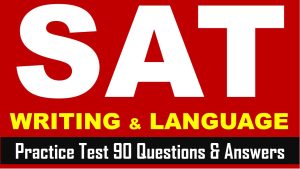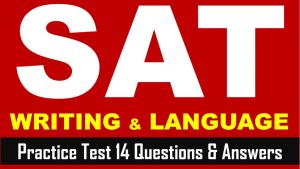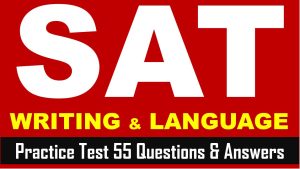Hi SAT Aspirants, welcome to AKVTutorials. As you know SAT (Scholastic Assessment Test) is a standard test, used for taking admission to undergraduate programs of universities or colleges of United States. SAT is developed and published by the College Board, an organization in United States, administered by the Educational Testing Service. Therefore, you need to do practice on SAT Reading Section, SAT Writing and Language Section. In this article, you will get SAT Writing Section Questions Practice Test 69 with Answer Keys AMBIPi.
Instruction:
- In the passage below is accompanied by a number of questions.
- For some questions, you need to think how the passage might be revised to improve the expression of ideas.
- For other questions, you will consider how the passage might be edited to correct errors in sentence structure, usage, or punctuation.
- Some questions will direct you to an underlined portion of a passage.
- Other questions will direct you to a location in a passage or ask you to think about the passage as a whole.
SAT Writing & Language Section Passage
SAT Writing Section Questions Practice Test Passage Title: Dr. King’s Guiding Light
Dr. Martin Luther King Jr. accomplished more than perhaps any individual in the struggle for African American rights. In the early stages of the civil rights movement, though, King struggled to reconcile the Christian doctrine of love with the immense challenge of achieving economic and social rights for African Americans. During this time of soul-searching, King was introduced to the teachings of a Hindu man who had fought on the other side of the 1 world—for the rights of the oppressed, Mahatma Gandhi. Gandhi’s principles of nonviolent resistance 2 was the primary influence that helped King build momentum in the American civil rights movement.
3 As early as 1919, Gandhi fought against the British government, which held India as a colony and subjected its people to unfair laws. Gandhi used methods such as the boycotting of British goods, peaceful marches, and fasting.
His ongoing campaign of nonviolent resistance eventually led to a major change in 1947 when Great Britain passed a resolution that outlawed 4 prejudicial discrimination against “untouchables”—India’s lowest caste of people. In 1950, King was introduced to Gandhi’s teachings through a sermon by Mordecai Johnson, who had just returned from a trip to India. After studying Gandhi’s achievements, King 5 concludes that Gandhi was the first person in history to use the Christian ethic of love as a “potent instrument for social and collective transformation.”
In 1955, King was given an opportunity to 6 bestow Gandhi’s techniques during the Montgomery, Alabama, bus incident. After Rosa Parks famously refused to give up her seat on a public bus, King organized a year long boycott 7 upon Montgomery buses, which ended with the U.S. Supreme Court ruling that segregation on public buses was unconstitutional. Over the next decade, King continued to rely on methods of nonviolent resistance by organizing 8 marches; and giving speeches; and instituting boycotts; and leading “sit-ins” at public establishments that refused to serve African Americans.
King’s efforts led to the passage of significant laws such as the 1964 Civil Rights 9 Act. This law prohibits discrimination based on race, color, religion, or national origin in public establishments. King eventually made his own trip to India in 1959, 10 but he would never meet the man who influenced him so deeply. Even before King began to learn of his principles, Gandhi had given his life for his cause. King once called Gandhi’s teachings “the guiding light of our nonviolent technique of social change.” 11
SAT Writing Section Questions Practice Test Questions
Question No 1
Which choice best maintains the sentence pattern already established in the paragraph?
Option A : No Change
Option B : world, for the rights of the oppressed,
Option C : world for the rights of the oppressed:
Option D : world for the rights of the oppressed
Answer
Show/Hide Answer
Option C : world for the rights of the oppressed:
Question No 2
Which of the following options is the most effective?
Option A : No Change
Option B : were
Option C : is
Option D : DELETE the underlined portion.
Answer
Show/Hide Answer
Option B : were
Question No 3
The writer is considering deleting the underlined sentence. Should the sentence be kept or deleted?
Option A : Kept, because it provides important information regarding the effects of the relationship between King and Gandhi.
Option B : Kept, because it serves to contextualize the social and political environment in which Gandhi operated.
Option C : Deleted, because it contains information that is irrelevant to the main topic of the second paragraph.
Option D : Deleted, because it contradicts the idea that Gandhi relied on nonviolent means to enact social change
Answer
Show/Hide Answer
Option B : Kept, because it serves to contextualize the social and political environment in which Gandhi operated.
Question No 4
Which choice results in the most effective transition to the information that follows in the paragraph?
Option A : No Change
Option B : and made illegal the
Option C : the prejudiced treatment and
Option D : DELETE the underlined portion.
Answer
Show/Hide Answer
Option D : DELETE the underline portion
Question No 5
Which choice best maintains the sentence pattern already established in the paragraph?
Option A : No Change
Option B : concluded
Option C : has concluded
Option D : was concluding
Answer
Show/Hide Answer
Option B : concluded
Question No 6
Which choice best maintains the sentence pattern already established in the paragraph?
Option A : No Change
Option B : exploit
Option C : operate
Option D : employ
Answer
Show/Hide Answer
Option D : employ
Question No 7
Which choice best maintains the sentence pattern already established in the paragraph?
Option A : No Change
Option B : with
Option C : of
Option D : about
Answer
Show/Hide Answer
Option C : of
Question No 8
The writer is considering deleting the underlined sentence. Should the sentence be kept or deleted?
Option A : NO CHANGE
Option B : marches; giving speeches; instituting boycotts and
Option C : marches, and giving speeches and instituting boycotts, and
Option D : marches, giving speeches, instituting boycotts, and
Answer
Show/Hide Answer
Option D : marches, giving speeches, instituting boycotts, and
Question No 9
Which choice most effectively combines the sentences at the underlined portion?
Option A : Act, which prohibits
Option B : Act and this law prohibits
Option C : Act, but the law prohibited
Option D : Act—this law prohibiting
Answer
Show/Hide Answer
Option A : Act, which prohibits
Question No 10
Which choice most effectively sets up the information provided in the next sentence in the paragraph?
Option A : No Change
Option B : accompanied by his wife, Coretta Scott King.
Option C : where he became further convinced of the effectiveness of Gandhi’s nonviolent resistance techniques
Option D : and there he studied more deeply the principles that would later inform his own actions.
Answer
Show/Hide Answer
Option A : No Change
Question No 11
Which choice best concludes the passage and most logically follows King’s quote about Gandhi in the previous sentence?
Option A : That “light” became particularly bright when India gained independence from the British government in 1947.
Option B : That said, the use of violent demonstrations likely would have also resulted in the achievement of civil rights for African Americans
Option C : Gandhi’s technique of nonviolent resistance was also used during the Rose Revolution in Georgia and the Orange Revolution in Ukraine
Option D : With these teachings, King helped light the path towards social justice and equal civil rights for African Americans.
Answer
Show/Hide Answer
Option D : With these teachings, King helped light the path towards social justice and equal civil rights for African Americans.



